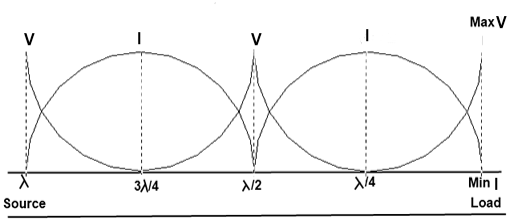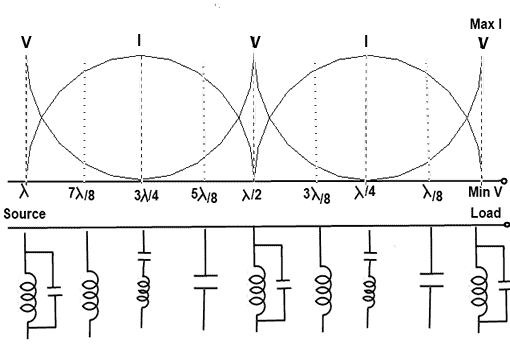Open Circuited Transmission Line
An open-circuited transmission line is a type of transmission line that has no load or termination at one end. This means that the voltage and current waves on the line are reflected back at the open end, creating standing waves and reactive power. An open-circuited transmission line can be used as a circuit element called an open stub, which is a short section of a transmission line connected in parallel with the main line. An open stub can be used for impedance matching, filtering, or other purposes, depending on its length and position relative to the main line. An open stub can also be used to create resonant circuits or antennas.

As shown in the diagram, at the open-circuited end the current is minimum and the voltage is maximum. At each λ/2 interval, this behavior is repeated if we move away from the load end towards the source.
As shown in the diagram, at λ/4 from the opened end the behavior of the voltage and current is vice versa to the short-circuited transmission line. It means that at λ/4 from the opened end, the voltage is minimum, and the current is maximum. This behavior is also repeated at λ/2 interval from the same point, or at the odd multiples of λ/4 on the transmission line.
As the current at the opened circuit end is maximum. At λ/4 away from the opened circuit point the impedance will be minimum because the current is maximum possible.
The open-circuited transmission line has an infinite voltage standing wave ratio and a unit magnitude of the voltage reflection coefficient. The voltage reflection coefficient is 180° out of phase with the incident voltage. The voltage is maximum and the current is minimum at the open end and at every λ/2 interval away from it. The first node of zero voltage is at λ/4 distance from the open end.
Characteristics of an Open-Circuited Transmission Line
An open-circuited transmission line has some distinctive characteristics that depend on the length and the frequency of the signal. Some of these are:
- The voltage and current on the line vary periodically along the line, with a wavelength equal to the wavelength of the signal in the line.
- The voltage is maximum and the current is minimum at the open end, and vice versa at the other end. This creates standing waves on the line, which can be measured by a device called a standing wave ratio (SWR) meter.
- The input impedance of the line depends on the length and the frequency of the signal. It can be calculated by the formula:
where is the input impedance, is the characteristic impedance of the line, is the phase constant of the signal in the line, and is the length of the line.
- The input impedance can be purely resistive, purely reactive, or complex, depending on the value of . For example, if , where is an integer, then , which means that the line acts like a short circuit. If , then , which means that the line acts like an open circuit.
Input Impedance of Open Circuited Transmission Line

As shown in the given diagram the open-circuited transmission line behaves as parallel resonant at the open-circuited end. The minimum current flow takes place at the open-circuited end.
At λ/2 away from the open end of the transmission towards the source, the behavior at this point will be capacitive. This behavior will repeat 5λ/8 from the open circuit end.
At λ/4 of the open circuit end of the transmission line, the circuit will behave as a series resonant circuit. It is due to the reason that the current will be the maximum possible.
At 3λ/8 is the open terminal at the transmission line, the behavior will be inductive.
At 7λ/8 the same behavior is repeated and so on.
The behavior of an open-circuited transmission line is a parallel resonant circuit or series resonant circuit or capacitive or inductive will repeat itself in the same manner towards the source at every λ/2 interval if the transmission line is long enough.
Some applications of open-circuited transmission lines are:
- Impedance matching circuits
- Filters
- Quarter-wave transformers
Some merits of open-circuited transmission lines are:
- They can replace discrete inductors and capacitors in some applications
- They can produce high voltages at the open end
Some demerits of open-circuited transmission lines are:
- They can cause reflections and standing waves on the line
- They can be affected by parasitic capacitance and radiation losses
Some real-life examples of open-circuited transmission lines are:
